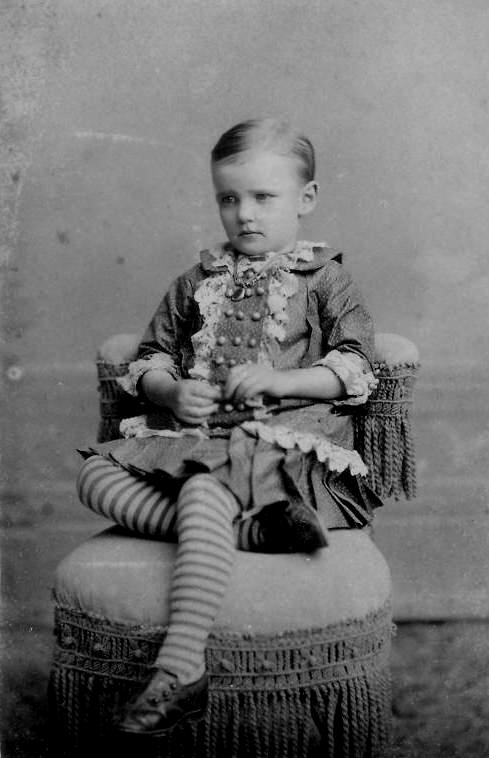
United States Skirted Garments: Features--Pleating

Figure 1.--This CDV portrait of an unidentified American boy is undated, but looks like the 1870s. Both CDVs ans striped stockings were popular in the 1870s. We are not sure if the boy is wearing a fancy kilt suit or a dress. The skirt part is heavily pleated. The boy looks to be about 4-5 years old. The CDV came from a Oio estate sale.
|
|
We do not yet have much information on the plearing used in American skirted garments. We note plearing being used in the 1860s, but it may have been used earler. We assume that it first becme a factor in skirted garments for boys when Queen Victoria's decesion to dress the royal princes in kilts (1840s), began to affect boy's fashions in America. This probably occurred in the 1850s with Highlnd kilt outfits. Kilt duits began to be n important style for boys in the late-1860s. We also notice pleated dresses and skirts. For American boys, however, the primary pleared garment was the kilt suit. The pleats were done in various ways and in different widths.
A pleat is essentially a fold formed by doubling the fabric back upon itself and then securing it in place. There are many different types of pleats. The most common pleat used in clothing is the knife pleat. It is the pleat used for the Highland kilt. Box pleats are a type of knife pleat, but dome back to back rather than as a series. The box pleats give the appearance of a wider pleat. The knife pleats are used for basic gathering and form a smooth line rather than springing out away from the seam they have been gathered to. The standard pleat is done in a 3:1 ratio–three, meaning that 3 inches of fabric will be needed to form 1 inch of finished pleat. Some motgers forned wider plears that did not require as much material. The practical purpose of pleating is basically to fit a garment so that it draws in close over smaller parts of the body (the waist) while becoming larger over wider parts of the body (the hips). In the case of kilts it becomes more a matter of style and fashion.
Chronology
We do not yet have much information on the plearing used in American skirted garments. We note plearing being used in the 1860s, but it may have been used earler. We assume that it first becme a factor in skirted garments for boys when Queen Victoria's decesion to dress the royal princes in kilts (1840s), began to affect boy's fashions in America. This probably occurred in the 1850s with Highlnd kilt outfits. Kilt duits began to be n important style for boys in the late-1860s.
Skirted Garments
Pleats are primasrily associated weith kilts, at least n connectin with boys. We notice both Highland kilts and kilt suits. We also notice pleated dresses and skirts. For American boys, however, the primary pleared garment was the kilt suit.
Pleat Types
The pleats were done in various ways and in different widths. We notice a Kansas boy in the 1880s with a dress that had wide pleats.
HBC

Navigate the Historic Boys' Clothing Web dress pages:
[Return to the Main U.S. skirted garment page]
[Return to the Main U.S. national dress page]
[Pinafores]
[Ringlet curls]
[Smocks]
[Bodice kilts]
[Kilts]
[Fauntleroy dresses]
[Sailor dresses]
[Fancy dresses]
[Dresses: 16th-18th centuries]
[Dresses: Early-Mid-19th century]
[Dresses: Late-19th century]
[Dresses: Early 20th century]
[Difficult images]
[Movie dresses]
Navigate the Boys' Historical Clothing Web Site:
[Introduction]
[Activities]
[Biographies]
[Chronology]
[Clothing styles]
[Countries]
[Bibliographies]
[Contributions]
[Essays]
[FAQs]
[Glossaries]
[Images]
[Links]
[Registration]
[Tools]
[Boys' Clothing Home]
Created: 8:50 AM 6/3/2010
Last updated: 1:33 AM 9/9/2010



